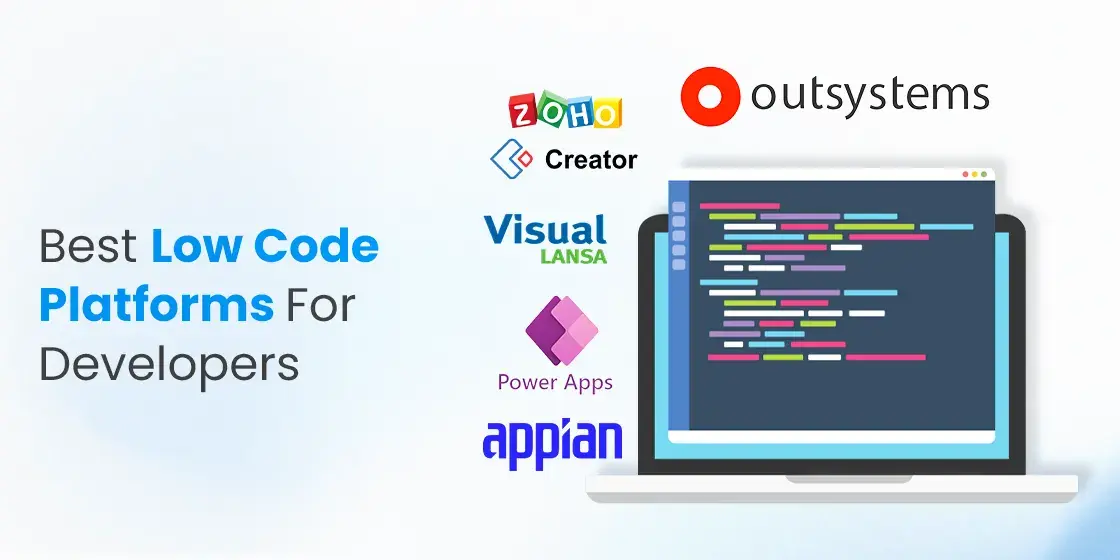Low-code applications greatly improve accessibility for non-developers. Often, they are referred to as "citizen developers" because of a variety of key factors. Intuitive Visual Interfaces:
Drag-anddrop Builders: Lowcode platform have drag-and-drop interfaces that let non-developers create visual applications without the need for code. The process of developing applications is now more accessible to those with no technical background.
WYSIWYG: WYSIWYG editors are "What you See is What you Get" editors that let users to design workflows and interfaces similar to the final product. This makes it easier to comprehend and use.
Simplified Workflow Design and Logic Design
Visual Workflow Design: Users are able to easily design business process and application logic with flowcharts, models and diagrams. They are easier to work with than traditional programming.
Pre-built Logic components: Low-code platforms include logic components already built (e.g. conditional statements and loops) that can be easily configured which eliminates the need for complicated coding.
Reusable Templates and Components:
Library of Templates pre-built: Numerous platforms that provide low-code come with a library of template types for common applications. This allows developers to begin their journey quickly and effortlessly and non-developers to modify the templates as they see fit.
Reusable Widgets And Modules: Users can make use of reused widgets. This makes it easier to create and reduces the need of deep understanding.
Guided Development and Tutorials
Step-by-Step instructions Platforms typically offer tutorials that are on screen, guided development pathways, and other tools to help people who are not developers to create applications.
Interactive Tutorials Interactive tutorials are hands-on and interactive and help users learn through doing. This boosts their confidence in the platform.
Integration of existing tools:
Seamless Integrate: Low code platforms are designed to seamlessly integrate with existing tools and systems in the business (e.g. the CRM or ERP) that allows non-developers, to create applications that work with current workflows.
APIs/Connectors: The built-in APIs/connectors enable non-developers to connect their apps to external services.
Collaboration Features:
Team Collaboration: Features such as real-time collaborative workspaces, as well as shared workspaces make it feasible for non-developers to work effectively with business analysts, developers and other key stakeholders.
Access Control Based on Roles: Users who do not develop are able to have access to roles and levels of access that allow users to contribute, without compromising security or functionality.
Automated Debugging and Testing:
Low-code platforms often come with a built-in testing and debugging tools that simplifies the process. Non-developers can now easily verify that their app is working correctly.
Platform detects problems when they happen and provides solutions. This helps non-developers with troubleshooting.
The general rule is that low-code development is able to democratize development. This is a major benefit for developers who are not. Low-code applications allow business users to participate actively in the development and maintenance of applications by providing intuitive visual tools and a guided experience. This bridges the gap between the technical implementation and business needs. See the most popular Low-code Platform for application development recommendations for website info including cross platform mobile app development, app development platform, rapid applications, rapid action development, stored sql procedures, microsoft azure sql, develop mobile application, rapid action development, developing mobile apps, app dev platform and more.

Advantages Of Low-Code Application Development In Terms Of Flexibility And Scale
Low-code software has many advantages when it comes to scalability. They are flexible and able to be modified to meet new demands. These are the main benefits:
Cloud-Based Platforms: Many platforms that are low-code-friendly are cloud-based. They let applications easily scale up and down with the cloud infrastructure. Businesses can handle more load without worrying too much about administration of servers.
Auto-Scaling Feature: Built-in features that automatically scale resources in order to meet demand can ensure consistent performance without manual input in peak hours.
Flexible Architecture:
Low-code platforms encourage modular design where components can independently be designed, tested and scaled. This flexibility improves flexibility and allows for easier upgrades or expansions of certain components without affecting the overall system.
Microservices Integration: Microservices Architecture support lets applications to be built as a set of loosely coupled services, enhancing the scalability as well as flexibility.
Customizable Solution:
Extensibility: Low-code platforms usually allow for customization of scripts and codes which lets developers expand the functionality of applications beyond the ones that are available. This allows unique business requirements to be met with no restrictions.
Third-Party Integrations: The capability of businesses to integrate APIs and third-party apps and add new functions to the application as needed, increases its capabilities.
Agile Development and deployment:
Continuous delivery and deployment Low-code platforms can be used with agile methodologies and facilitate continuous integration and delivery (CI/CD). This enables rapid deployment of updates and the introduction of new features, allowing applications to develop rapidly in response to customer feedback and changes to the market.
Iterative Development - The low-code method permits applications to be upgraded and scaled gradually which reduces risk and allows for more controlled growth.
Resource Optimization
Low-code platforms can track and manage the performance of an application and help optimize resource usage. This will ensure that resources are utilized effectively. They are also able to be scaled up or down depending on the needs of the user.
Load-balancing: Features that spread workloads equally across servers improve the ability of an application to handle large traffic and ensure consistent performance.
Global Reach
Multi-Region Availability: Lowcode platforms allow the deployment of applications across different regions. Businesses can provide users low-latency worldwide access. This is particularly important for applications that are popular with a worldwide user base.
Support for Localization. Inbuilt support for localizing applications allows them to be easily adapted to different languages, regional demands and improves their flexibility in diverse markets.
Updates and maintenance
Simple maintenance: The visual and modular nature of low code applications simplifies maintenance tasks. They permit updates and bug corrections to be carried out quickly without lengthy downtime.
Version Control Systems that integrate versions control can assist you in managing updates, rollbacks and changes. They can ensure that they can be released in a safe manner and that previous versions can be restored when needed.
Cost Efficiency:
Lower Development Costs: By reducing the need for extensive coding, low-code platforms lower development costs and enable to scale apps without a substantial increase in cost and effort.
Pay-Asyou-Go Models Many low code platforms have flexible pricing options, such as the pay-asyou-go model, which aligns costs with actual usage and growth. This provides flexibility in the financial plan.
Low-code development provides businesses with many advantages, including scalability, flexibility, and flexibility. This lets them create robust, adaptable and scalable applications. These platforms allow quick adjustments to the changing requirements and efficient use of resources and constant advancement. This guarantees that the application can grow with the business. See the recommended Enterprise application development with Low-code Platform blog for blog tips including develop web app, develop mobile application, rad application development, push notifications, rapid application design, database in azure, app modernization, develop mobile application, push notifications android, low code platforms and more.

The Advantages Of Low-Code Development For Both Community And Vendor
Low-code application development platforms have substantial advantages in terms of the support provided by vendors and communities. Both are essential for an effective implementation, ongoing maintenance and constant improvement of applications. Here are the top benefits: Support from the vendor
Comprehensive Technical Support:
Support Teams with Dedicated Support: Many low-code platforms have access to dedicated support teams who can help in technical problems, troubleshooting, and provide guidance to ensure that all issues are solved quickly.
24/7 Support Certain vendors are accessible all hours of the day This is useful for businesses operating in multiple time zones.
Onboarding and Training:
Training programs that are structured: Vendors offer structured training courses, such as webinars or courses for certification. This helps users to quickly master the platform.
Customized Onboarding : Many vendors offer customized onboarding services that assist new customers integrate the platform and tailor it to suit their particular needs.
Regular Updates and Enhancements
Continuous Improvements: Low-code providers frequently release updates, which include performance improvements as well as new features and security patches to keep their platform current.
Feedback Integration: Vendors typically include feedback from users into their development processes, ensuring that their platform is constantly evolving to meet the evolving requirements of their users.
Comprehensive Documentation:
Documentation: A detailed documentation is available for most products. It covers everything from the basics to the most advanced customisation. This can help users find solutions by themselves.
API References: Comprehensive API documentation helps developers integrate the low-code platform into other systems and customize their applications effectively.
Professional Services and Consulting:
Expert Consultation. Vendors offer a range of consulting services including architectural design along with strategic planning and platform implementations. They ensure that customers get the most out of their platform.
Custom Development: Some vendors offer services that allow them to develop specific features, or incorporate the features, but they aren't available in the standard version.
Community Support for the Community
Active User Community:
Forums and Discussion Boards Numerous low-code platforms have lively online communities in which users can seek answers, discuss solutions, and collaborate on the best practices.
Meetups and User Groups: Local or virtual user groups and meetings provide opportunities to learn, network and sharing your experiences.
Collaboration and Knowledge Sharing
Community-Contributed Resources: Users often share templates, modules, and extensions that they have developed, which can be reused or adapted by others, accelerating development and innovation.
Crowdsourced Solutions: The collective wisdom the experience, expertise and experiences of a group can be an effective tool for solving problems and coming up with creative solutions.
Learning and Development:
Community-led training: Many groups hold workshops, training sessions, and webinars. They are usually conducted by experts in the field, who provide practical advice and advanced techniques.
Online Tutorials and Courses Community members often create and share online tutorials, courses, and guides on how-to, which enhance the resources for learning accessible to all users.
Feedback and Influence
Product Feedback Channels Community forums contain a number of channels for giving feedback to vendors. This can influence the design of features.
Beta Testing Programmes: Community members who are active could be able to participate in beta programs. This gives them an early glimpse of the latest features, as well as an opportunity to contribute to the platform’s evolution.
Recognition and support
Many vendors offer community recognition programs for community recognition. These programs honor active community members and include MVP programs.
Peer support: Community members are often willing to offer peer-support, offering their expertise and guidance to those who may be less experienced. They help create a supportive environment through encouraging cooperation and creating a positive atmosphere.
Overall, the combination of robust vendor and active and engaged communities. They provide a comprehensive environment for assistance with low-code development of applications. The developers will benefit from the experience and resources they need to build and deploy their application.
